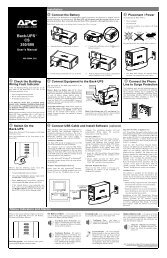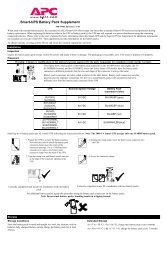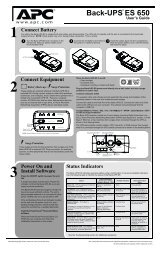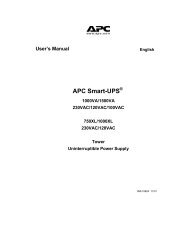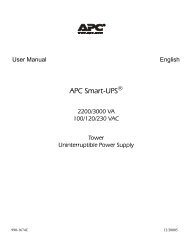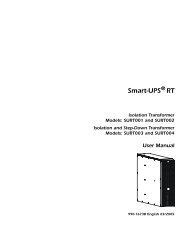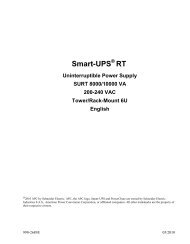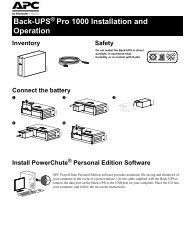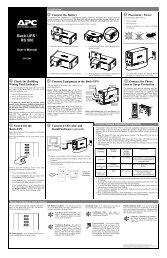Back-UPS® - APC Media
Back-UPS® - APC Media
Back-UPS® - APC Media
Create successful ePaper yourself
Turn your PDF publications into a flip-book with our unique Google optimized e-Paper software.
4.0 Principles of operation<br />
4.6 Transformer<br />
The UPS’s transformer is an electrical component which “steps up” the output<br />
voltage of the inverter to the normal utility line voltage. In addition, it serves to<br />
isolate the UPS from equipment failures.<br />
4.7 Monitoring and control electronics<br />
This block is the “brain” of the UPS. The monitoring and control circuitry detects<br />
utility failures such as blackouts, sags and brownouts; synchronizes the inverter’s<br />
output frequency and phase to that of the utility; detects low battery voltage<br />
conditions; directs the load transfer switch; and governs all user controls,<br />
indicators and computer interface functions.<br />
4.8 Operation during a utility failure<br />
In anticipation of a utility failure such as a blackout, swell, sag or brownout, the<br />
UPS continuously monitors the utility voltage and readies the inverter for<br />
“synchronous” transfer. This means the inverter’s phase and frequency is<br />
adjusted to match the phase and frequency of the utility. If the utility voltage falls<br />
outside acceptable limits, the UPS rapidly transfers your equipment to power<br />
derived from the UPS’s battery via the inverter and transformer described earlier.<br />
This transfer typically takes place within 3 milliseconds. Once operating in this<br />
mode, the UPS will emit a series of four beeps once every 30 seconds to remind<br />
you that the continuation of power is limited in duration. If the utility power is<br />
not restored to normal, the UPS will eventually sound continuous beeps to alert<br />
you that less than two minutes remain before the UPS shuts down and ceases to<br />
power your equipment. This is called a low battery condition which means that<br />
the UPS’s usable battery capacity is nearly spent. The UPS will automatically<br />
shut down if the UPS is not turned off during the low battery alarm.<br />
If the UPS detects the return of normal utility voltages at any time during<br />
operation using its alternate power source, the inverter voltage will be smoothly<br />
re-synchronized to match the phase and frequency of the utility. Once synchronized,<br />
the load transfer switch will re-transfer your equipment to power supplied<br />
by the utility. After an extended utility outage, the battery charger resupplies the<br />
battery with energy at a pace which is consistent with maximizing the service life<br />
Page 16






